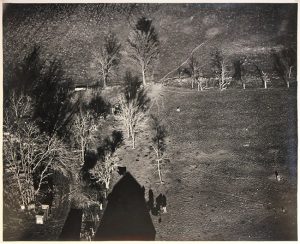
 In 1940, Woody Guthrie wrote the song, “This Land is Your Land.” Photographer Marilyn Bridges, whose work is included in three sections of this exhibition, observed in 1990, “This song affirms the grandeur of the land as a symbol for the unlimited possibilities of a people blessed with this ‘land of good and plenty.’ But the years have not been good to the earth. Mankind has flexed its muscles and challenged the land to a test of durability. There can be no winners in this contest. For there can be no doubt that while the land will exist without people, people cannot live without the land.”[footnote]Marilyn Bridges and William Least Heat-Moon, This Land is Your Land: Photographs by Marilyn Bridges Across America by Air (New York: Aperture, 1997), p. 106.[/footnote]
In 1940, Woody Guthrie wrote the song, “This Land is Your Land.” Photographer Marilyn Bridges, whose work is included in three sections of this exhibition, observed in 1990, “This song affirms the grandeur of the land as a symbol for the unlimited possibilities of a people blessed with this ‘land of good and plenty.’ But the years have not been good to the earth. Mankind has flexed its muscles and challenged the land to a test of durability. There can be no winners in this contest. For there can be no doubt that while the land will exist without people, people cannot live without the land.”[footnote]Marilyn Bridges and William Least Heat-Moon, This Land is Your Land: Photographs by Marilyn Bridges Across America by Air (New York: Aperture, 1997), p. 106.[/footnote]
In this photograph, Bridges uses the shadow of a barn in the foreground to imply that we are looking at farmland, while the trees and their shadows suggest a natural world apart from human alterations. Bridges’ aerial viewpoint distances the viewer, literally and figuratively, from the scene. In place of the customary intimate position of walking level, the aerial shot enables the viewer to view the scene in what one scholar has called the “post-human” gaze of a survelliance camera or reconnaissance satellite.[footnote]Joshua Schuster, “Between Manufacturing and Landscapes: Edward Burtynsky and the Photography of Ecology.” Photography & Culture 6(July 2013), pp. 207-08.[/footnote]